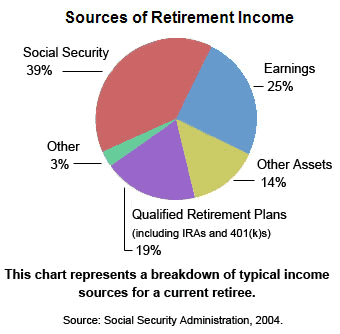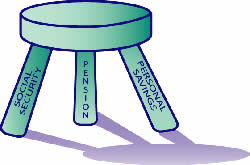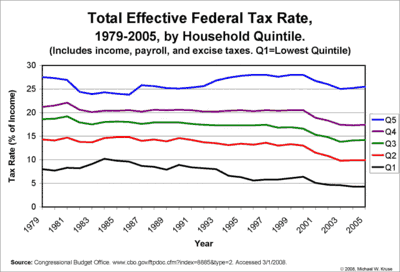You may have heard the term “three-legged stool”, taken from the idea that a stool needs three legs to maintain balance. (Photographers use tripods, no duopods or quadrapods. Even a four-legged chair will likely wobble.)
Old Three-Legged Stool of Retirement
Traditionally, the components of the three-legged stool of retirement have been presented as Social Security benefits, Pensions, and Personal Savings (401k, IRA, and other assets).
This is partially supported by data from the Social Security Administration:

image via Pbs.org
The Qualified Retirement Plans slice combines pensions, 401ks, and IRAs together, making it hard to see the breakdown. The Other Assets include income from other investments like capital gains or dividends from taxable accounts and real estate. We observe that a quarter of all income in retirement is still from working for a paycheck.
Shaping Your Own Retirement Legs
These are just averages, and each of us will have their own path to retirement. If you’re planning on retiring early, you won’t have Social Security yet. For people born after 1960, the full retirement age for benefits is already 67, and expect it to rise even further the younger you are. I think some form of SS will still be around when I’m 70, but who knows.
1. Flexible, reliable, part-time income
We already saw that lots of people over 65 still work. Even though I want financial independence early, I’ve also come to realize that I’ll never stop working. Ask yourself what are you really going to do in retirement? In addition, I think it would be stressful to stare at a big pile of cash and think to myself – “Crap, I hope this lasts for 30+ years!” Maintaining a part-time job and the related skills would help my cashflow, and also ensure that I could return to the workforce if disaster strikes.
I would want a part-time job that could provide some socialization and a sense of improving your community or helping others. Most of my imagined jobs involve teaching, coaching, sporadic technical consulting, or something tourism-related. It can’t be 9-5, and I’d want to be able to take months off at a time. This won’t be easy to find, so I need to start developing more “fun” skills as well as personal relationships now.
2. Personal Savings: Accumulate 30 times annual (non-housing) expenses
Without a pension or Social Security, you’ll need to live off your own savings. If you invest in a balanced portfolio of 60% stocks and 40% bonds, studies have estimated that you can have a “safe withdrawal rates” of about 4% per year. By being a bit more conservative than that, this means accumulating 30 times your annual expenses.
For example, if your annual expenses are $30,000, then you need to save $900,000. This is a very general rule of thumb. Taxes are tricky, but if your income is only $30,000 per year, you won’t be paying very much income tax. Check out the historical effective tax rate over a past 25 year timespan:
For reference in 1995, to be in the bottom 50% (safely in Q1/Q2) your adjusted gross income had to be under $31,000. And this even includes payroll taxes of about 9%, which you won’t have to pay on investment income. The result: very low taxes (possibly under 5%) if you keep your expenses down! Which brings me to…
3. A Paid Off House
I don’t think everyone needs to own a home. However, I happen to enjoy many of the intangibles of owning a home, I love my house and neighborhood, and plan on staying here a while. The cost of this leg can vary widely, from a $1,900 house in Detroit to… where I live, so choose where you want to live carefully. 😉
Financially, owning a home protects you from future inflation and rising rents. You are still subject to property taxes and maintenance costs.
In addition, not having to pay rent means you need less income from savings, reducing your needed nest egg in #2 above. You also pay less taxes. Withdrawing additional money from an IRA, for example, will mean subjecting them to your marginal tax rate, which could be 25% or higher. So to pay $750 in rent, you’d have to withdraw $1,000. Not very efficient.
So there, you have it, my three-legged stool. Yours may be very different – you may like renting, have a pension, own investment property, or have some other sources of income. I still worry about health insurance, but I’m still hopeful that some positive health care reform will occur that will create affordable health insurance for individuals under 65 not covered by an employer group plan.
* You can read more about the last two legs in my related post A Quick & Dirty Plan To Reach Financial Freedom.


 The Best Credit Card Bonus Offers – March 2024
The Best Credit Card Bonus Offers – March 2024 Big List of Free Stocks from Brokerage Apps
Big List of Free Stocks from Brokerage Apps Best Interest Rates on Cash - March 2024
Best Interest Rates on Cash - March 2024 Free Credit Scores x 3 + Free Credit Monitoring
Free Credit Scores x 3 + Free Credit Monitoring Best No Fee 0% APR Balance Transfer Offers
Best No Fee 0% APR Balance Transfer Offers Little-Known Cellular Data Plans That Can Save Big Money
Little-Known Cellular Data Plans That Can Save Big Money How To Haggle Your Cable or Direct TV Bill
How To Haggle Your Cable or Direct TV Bill Big List of Free Consumer Data Reports (Credit, Rent, Work)
Big List of Free Consumer Data Reports (Credit, Rent, Work)
Jason,
Do not worry about health costs. In the worst case, you could always consider moving to Canada which has almost a free healthcare system 😉
Oops I meant Jonathan , sorry ;-(
In the discussion of Step 2, a very important variable is missing….INFLATION. Even at a conservative rate at 3%, 30k in 30 years will only be worth approximately $12,500 with inflation eating our dollars like they are at an Old Country Buffet. Therefore, using the same calculation of 4% interest rate, you will need around $100,000 annual income to match a $30,000 salary in today’s dollar. And to get $100,000 dollars in income at 4% interest rate, you will need to have approximately $2.5 million saved up. But, who wants to live on a $30,000 a year salary, so someone around the age of 30-35 years old will need much more money than $2.5 million dollars if they want to retire comfortably at the age of 65.
On a very depressing side note, at the rate the government is spending (printing) money; inflation will far exceed the conservative rate of 3%, so this will require individuals to save even more money then discussed above.
At Albert: Actually, I think Jonathan makes the assumption that the 30 years of savings will grow with inflation. Please correct me if I am mis-speaking, but if you need $30,000 per year and have $900,000 saved. Then you need to invest the assets such that you earn the rate of inflation plus the withdrawal rate. So, if inflation is 3% and you withdraw 4%, you need to earn 7% on your money. If you earn less than that, you will start to eat at principal.
Historically, you can earn a 4% above inflation return with no more than 50% invested in equities.
I agree with working part-time at something as long as you can. I like to be around people and have structure (money and potential benefits are nice too!). The Economist 6/26/2009 has a nice article on Retirement and thinks many should consider working in their later years.
Re: Inflation.
The 4% safe withdrawal rate, in most all studies, does include inflation in one form or another. For example, you withdraw 4% initially, and then adjust the 4% amount with inflation. If you withdraw $30k the first year and inflation goes up by 3%, then the next year you take out $39,000. There are slight variations to improve your likelihood of not running out of money.
The actual sum you need will adjust as your expenses increase with inflation. If you spend $20,000 today, you’d need $600,000 in today’s dollars. If you end up needing $50,000 by the time your retire, then you’d need $1,500,000. The actual *savings rate* you need to keep up to get to number will depend on your assumed after-inflation (real) return.
If I need $600,000 in today’s dollars, I can estimate what I need to save each money by assuming a real return of say 4%.
The part time job is a good idea for everyone who is able; a paid-off house is ideal. My issue with self-funded retirement, though, is the disparity in savings between men and women on average.
Most women’s working lives are interrupted by bearing and raising children, and women tend to be slugged with other carer roles, like caring for elderly parents, which means that women are far more likely than men to work part-time or not at all, and for those women who go back to working full-time the usual promotion pattern has often been disrupted. Women returning to the work force are therefore less likely to be promoted to higher-paid positions, or at least not in the same timeframe as men.
On average, women spend around 20 years in the paid work force, compared to around 38 years for men, and accumulate around half the retirement savings of men. This discrepancy means that many more women than men are left to rely on the age pension, and experience financial difficulties in retirement.
Not that I have any solutions to offer, but I wanted to get opinions on how to get around this issue?
You can retire with 100k in the bank. Just live frugally and don’t subscribe to the American shopaholic craze and advertising propaganda blitz and keep up with the Joneses stupidity. Heck, the happiest people I’m meeting are those collecting maximum unemployment (some 500/week) to do NOTHING for over a year with extensions. Most got packages/buyouts worth another 30-70k after tax. Many have wives working since women are the preferred gender in the workforce. 😉
Instead of working a part time job, how about a part time business? I much prefer that approach because it allows me to control what and when I want to do things.
Based on current conditions in Washington and all the states, I would expect taxes to increase pretty significantly. Investing in municipal bonds or muni bond funds can allow you to get good returns that are tax free. Being tax free they will have a bigger bang than a taxable return.
Something to think about.